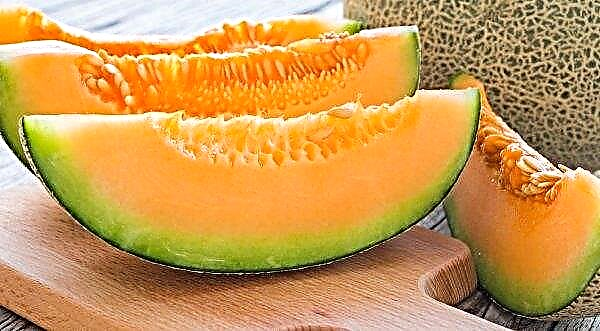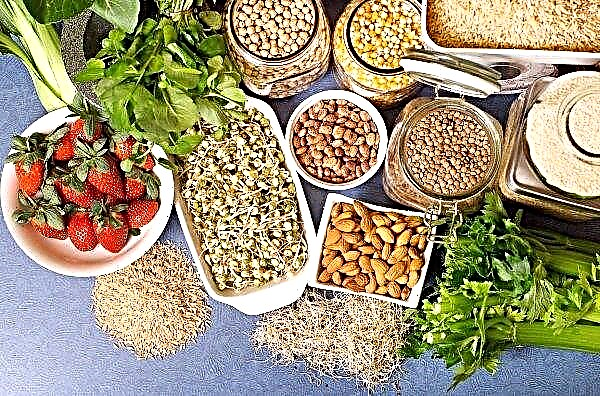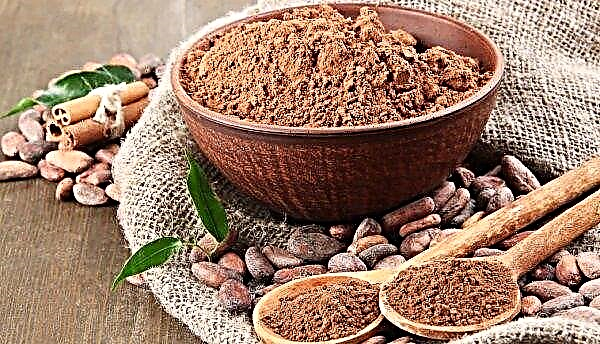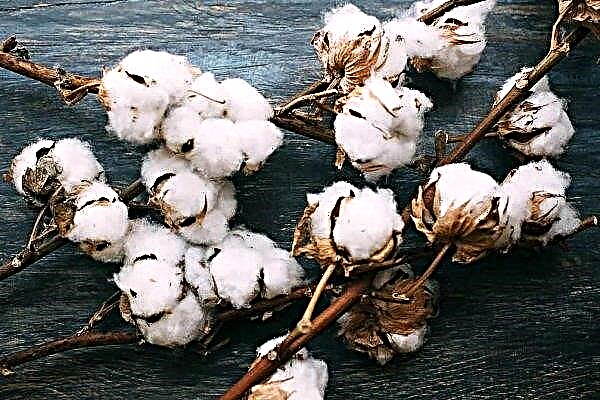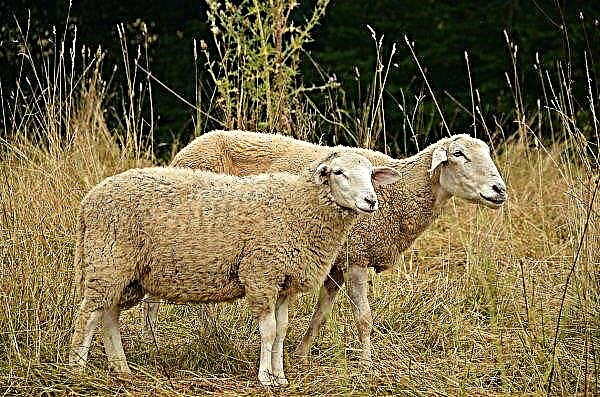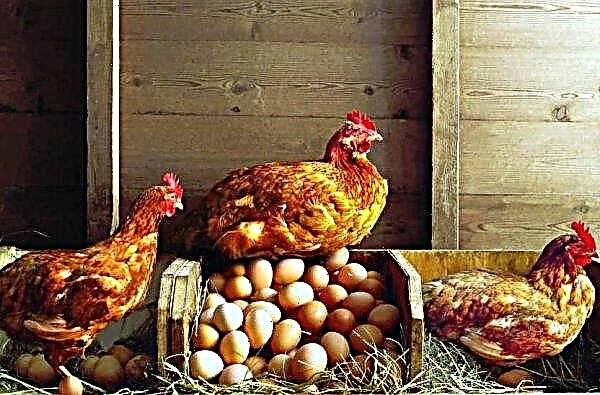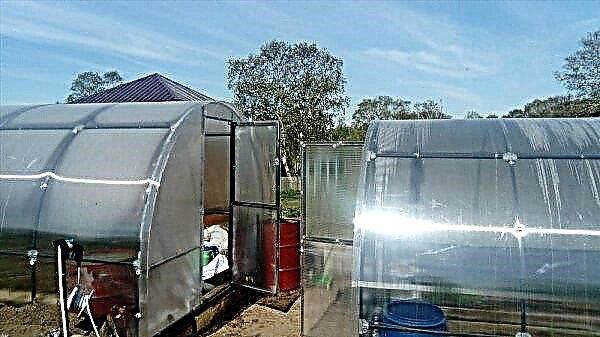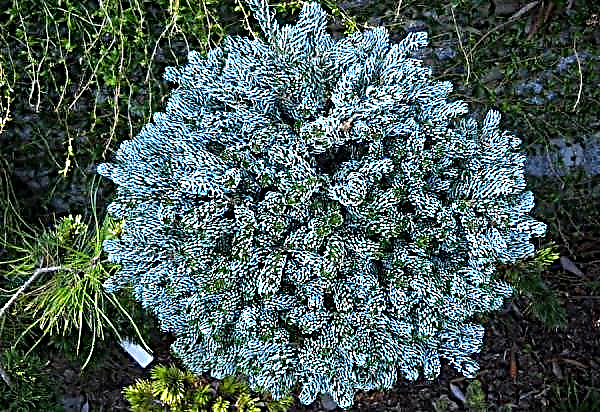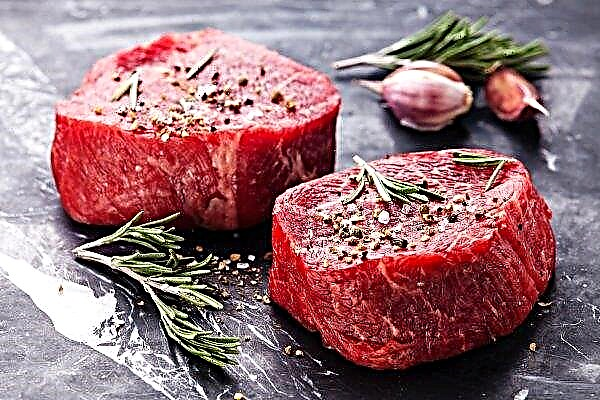Gerber Jameson is one of the types of flower that is most often grown at home. It is short-lived, therefore it requires frequent rejuvenation. For the reproduction to be successful, and the flower to grow beautiful and healthy, you need to know how to properly care for it and in what ways to propagate.
Botanical description of the plant
Gerber Jameson is a natural South African species that has been used to select most flower varieties and hybrids. It has powerful, highly branched roots resembling tangled shoelaces.
Did you know? Gerbera is an important crop commercially because it is fifth in the list of flowers with the highest sales in the world. Most popular among buyers are only roses, carnations, chrysanthemums and tulips.
The stem is thick, reaches a height of 30 cm. The leaves are light green in color, have wavy edges, combined into a basal rosette. The flower stalk is strong, single, 20–25 cm high. The flowers are collected in baskets. They look like daisies.
They can have different colors, except for blue and blue. Flowering lasts from early summer to mid-autumn. After flowering, a fruit-seed appears, which contains 300-500 seeds weighing 1 g.
Conditions for growing at home
Among the preferences of gerbera - good lighting, high humidity, warm temperatures, lack of drafts. Caring for a room flower is simple - you will need only regular watering, top dressing, sanitary pruning and transplanting.
Location and Lighting
In the room, the gerbera should be put in the brightest place. The recommended location for maximum decorativeness is the western or eastern windowsill. When grown on a southern window, there is a high risk that the plant may get sunburn and it will be too hot.
Therefore, it is imperative to scatter light. It is undesirable to grow a flower on the north side. If there is another option, then additional illumination is needed, which will extend the daylight hours to the required 10-12 hours.

Temperature and humidity
Indoor gerbera blooms well at a temperature of + 20 ... + 22 ° C. Higher temperatures lead to a decrease in the decorativeness of the plant and a deterioration in flowering. When the indoor culture does not bloom, the temperatures + 14 ... + 16 ° C will be optimal for it.
Lowering the thermometer column below + 10 ° C is dangerous for the flower. Drafts and temperature changes are also harmful to him. When airing a room, it is better to take the flower out to another room in order to avoid exposure to cold air currents.
Humidity for gerbera is needed above average - at the level of 60–80%. When the weather is hot outside, you need to spray from the spray gun. At the same time, it is necessary to moisten not the flower itself, but the space around it, since moisture entering the leaf sockets and petals can lead to the development of diseases, burns and the appearance of unaesthetic spots.
You can maintain the desired level of humidity if you put the pot on a pallet filled with moistened pebbles, expanded clay. Another way is to purchase and install a device for humidification of air in the room.
Growing from seeds at home
Gerbera pleases with its decorative effect and long flowering for a short time. Starting from the fourth year of life, it blooms not so plentifully and for a long time, its leaves are fading. Therefore, during this period it must be rejuvenated. This can be done by propagation by seeds in February - March or after their collection. Of these, seedlings are first grown.

For reproduction you will need:
- purchase boxes for sowing;
- buy or mix soil.
Tanks for landing should be small and wide. The soil is light, loose and nutritious.
It is bought in a specialized store or mixed from the following ingredients:
- turf soil, sheet soil, humus, sand (proportions 2: 1: 1: 1);
- hardwood, sand (2: 1).
The recommended pH level for the soil for planting seedlings is 5.5–6.5. Before sowing, the earth is subject to disinfection - it is watered with potassium permanganate, calcined in the oven (microwave) or kept over steam. After mixing, the substrate must be poured with a solution of potassium permanganate. Before laying it in the landing box, put a layer of drainage on the bottom.

In addition to soil, preparation also requires seed material. After it is assembled, it must be dried at a temperature of + 25 ... + 30 ° C and pickled with potassium permanganate. Then soak in warm (+ 40 ° C) water for several days, for a couple of hours in a growth stimulator and completely dry.
The technology of sowing seeds for seedlings is as follows:
- Lay the drainage layer on the bottom of the tank.
- Fill a layer of prepared soil substrate.
- Moisturize it.
- Spread seeds on its surface according to a 2 × 2 pattern.
- Sprinkle them with a thin layer of earth.
- Cover the container with glass or film.
Important! Gerbera seeds retain their germination for 6 months. It is during this period after collection that they must be placed in the ground.
After that, the box with seedlings is put in place with a temperature of + 18 ... + 20 ° С. It should be well lit by sunlight. Plantings need to be opened daily to give an influx of fresh air and thereby protect them from the development of fungal infection. As the soil dries, it must be moistened with a spray gun.
If everything is done correctly, then the sprouts should hatch in 7-10 days. Then the glass or film is removed completely. When 4-5 leaves are formed on plants, they need to be dived into pots with a diameter of 10 cm.
Video: Growing Gerbera Jameson from seeds
Features of plant care at home
In the future, the plant will require care, consisting of simple standard procedures. It must be regularly watered and fed, as well as transplanted.
Watering
Gerbera loves frequent, moderate watering. Dangers for it are also droughts and waterlogging. When drawing up the irrigation regime, they are guided by the state of the soil. Moisturizing is done when its surface layer dries.
Thus, the frequency of irrigation will depend on lighting, humidity, pot material and other factors. Typically, a gerbera is watered 2-3 times every 7 days during the growing season and once every 7-10 days during dormancy in winter.
It is forbidden to water a houseplant with just fresh tap water. It must be left for 1-2 days or filtered to soften and remove impurities that are dangerous to plants. Recommended water temperature - + 20 ... + 22 ° С.Important! When watering, you need to make sure that moisture does not get inside the leaf outlet. This can lead to the development of fungal diseases.
Top dressing
Starting in March and ending in October, the plant needs to be fed. They are necessary for the flower to be healthy, bloom profusely and for a long time. For top dressing, ready-made complex fertilizers are developed, developed for indoor crops, for example, “Master”, “Agricola”, “Florovit”. Preparing them according to the instructions, you should reduce the dosage by 2-3 times. Organic fertilizers for gerbera are not suitable.

Pruning
Pruning to form a crown for Jameson's gerbera is not needed. In spring and during flowering, it is necessary to cut off faded buds, yellow, damaged leaves.
Transfer
A transplant is best done annually in early spring. For her, you need to buy a new pot, which will be 2-3 cm larger in diameter from the previous one. It is desirable that it be ceramic. Land for landing can also be bought. Any universal primer designed for flowering indoor crops is suitable. Soil can be made up independently.
To do this, mix the following ingredients:
- sheet earth (3 parts);
- peat crumb (1);
- sand (1);
- charcoal (1).
There is one more option:
- fertile turf (4 parts);
- peat crumb (2);
- sphagnum moss (2);
- pine bark (1).
Before planting a flower, the ground must be etched.
Important! When transplanting, you need to control that the earth does not fall into the outlet of leaves. This leads to the fact that the plant becomes ill.
In order to transplant a gerbera, you must perform the following steps:
- The day before the planned procedure, the flower must be well watered so that later it can easily come out of the pot.
- At the bottom of a new pot, place a drainage layer 20–25% high of the entire tank.
- Fill a layer of new soil.
- Extract flower from pot.
- Move it, without destroying the earthen coma, into a new pot, putting it in the center.
- Fill the voids with earth so that 1.5–2 cm remains from the edge of the pot.
- Watering.

How to propagate a flower
In addition to the seed method, a gerbera can be propagated vegetatively: divide the bush and rhizome, root the cuttings.
Dividing the bush
The division of the bush is carried out during the transplant. The bush is divided into 2 or more equal parts, so that in each of them there remain 2-3 growth points. For parts, you need to shorten the roots and treat the slices with crushed activated or charcoal. Then they need to be planted in separate pots. The growth point should be above ground level.
Rhizome division
Rhizome division is also necessary when transplanting. The plant is removed from the pot, the roots are cleaned, damaged and diseased are removed, and then they are divided into 2 equal parts. Gently cut and process the sections with coal. After drying, the parts are seated in separate containers.

Cuttings
Cuttings produced in the spring. A piece of rhizome with 1-2 leaves is separated from the plant. Roots need to be cut by 1/3. The cuttings are planted in moist soil. So that it takes root, it is placed in a temperature of + 20 ... + 25 ° C and humid air. The roots should appear after a month. Then the young plant needs to be transplanted into a permanent pot.
Did you know? Derivatives of coumarin are present in the leaves, stems and roots of gerbera - a substance used to produce sweet, grassy with a hint of fresh hay, tobacco aroma in 90% of perfume compositions.
Possible growing difficulties
If the gerbera is undergoing quality care, and it grows in the conditions necessary for it, then most likely the owner will not encounter problems when growing it. Errors of the grower threaten the development of diseases and defeat by pests.
Gerbera can get sick with the following diseases:
- Gray rot. It develops if the flower is often poured, as well as in the event of moisture entering the leaf outlet. It appears as dark spots on foliage with a gray coating. Treatment consists in the removal of parts affected by the disease, treatment with systemic fungicide and transplantation into new soil and capacity.

- Root rot. It affects the plant if it is grown in cold temperatures and with excessive watering. At the initial stage, a flower can be transplanted into a new land and a pot. Before planting, you should carefully inspect the roots, remove damaged ones, and healthy ones should be treated with a fungicide. With the running process, the plant must be disposed of. If possible, then it is possible to produce propagation by cuttings.

- Powdery mildew. It occurs if the plant experiences temperature changes and is watered too abundantly. Irrigation with cold water can also lead to the disease. The main symptom of the disease is a white coating on the leaves, similar to flour. The affected leaves must be cut, and the bush treated with Fitosporin-M.

Of the pests for the flower, a great danger is:
- Spider mite. The insect attacks those plants that grow in dry air and in hot conditions. To get rid of the sucking parasite, it is urgently necessary to increase the humidity and spray with “Acttellik”, “Fitoverm”, “Flumayt”, “Akarin” or other drugs of similar action.

- Whitefly. This small butterfly with white wings lays larvae that eat leaves. Struggling with them with the processing of "Actellic", "Actara", "Match".

In addition to diseases and pests, other problems can be observed:
- Leafs fade and dry. Such a change in the appearance of the plant can occur for two reasons: due to improper irrigation regimes (waterlogging or prolonged drought), due to low humidity. To fix the problem, you need to properly water the flower and increase the humidity in the room.
- Missing flowering. This happens if the plant does not have enough light, if it is planted in a too big pot or if it was improperly fed, resulting in an excess of nitrogen in the soil. You need to rearrange the pot in a lighter place. In case of a large capacity, a transplant is required.
- The foliage turned yellow. This symptom indicates that the plant is waterlogged or it is affected by cold air currents. Leaflets may also turn yellow due to aging. It is necessary to establish the exact cause of yellowing and eliminate it.






